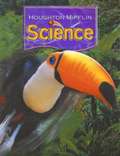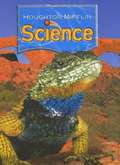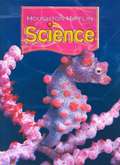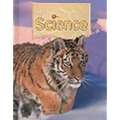- Table View
- List View
Houghton Mifflin Reading: Surprises
by Houghton Mifflin HarcourtThe book is full of beautifully illustrated stories and is in a simple language. The book is for beginning readers. The biggest bonus in this book is cover-to-cover full-color presentation coupled with discussion questions at the end of each story unit.
Houghton Mifflin Reading: Theme Skills Tests Blackline Masters (Grade #2)
by Houghton MifflinThe book contains six themes skills test on Silly Stories, Nature Walk, Around Town: Neighborhood and Community, Amazing Animals, Family Time, and Talent Show.
Houghton Mifflin Reading: Treasures
by Houghton Mifflin HarcourtThe book is for beginning readers. The biggest bonus in this book is cover-to-cover full-color presentation coupled with discussion questions at the end of each story unit.
Houghton Mifflin Science (Grade #1)
by Houghton MifflinThis science text book contains topics on Plants, Animals, and People, Living Things and Where They Live, Earth, Our Home, Weather and the Sky, Describing Matter and Energy Sources and Motion.
Houghton Mifflin Science (Grade #3)
by Douglas Carnine Catherine Valentino William Badders Bobby Jeanpierre James Feliciani Carolyn SumnersTopics broadly covered in this book are: living things, earth, matter, energy and change.
Houghton Mifflin Science (Grade #4)
by Douglas Carnine Catherine Valentino William Badders Bobby Jeanpierre James Feliciani Carolyn SumnersScience textbook for 4th graders.
Houghton Mifflin Science (Grade #6)
by Douglas Carnine Catherine Valentino William Badders Bobby Jeanpierre James Feliciani Carolyn SumnersThe textbook contains unit lessons on: Continuity of Life, The Changing Environment, The Dynamic Earth, Earth in the Universe, Matter and Its Properties, Energy and Forces, and Motion.
Houghton Mifflin Science Discover Works (Grade 4, Texas edition)
by William Badders Donald Peck Lowell J. Bethel Victoria FuTo think like a scientist, learn as much as you can by observing things around you. Everything you hear, smell, taste, touch, and see is a clue about how the world works. As you test your ideas, you'll continue to make careful observations.
Houghton Mifflin Science Discovery Works
by Catherine Valentino William Badders Carolyn Sumners Donald Peck Lowell J. Bethel Victoria FuTo think like a scientist, learn as much as you can by observing things around you. Everything you hear, smell, taste, touch, and see is a clue about how the world works. As you test your ideas, you'll continue to make careful observations.
Houghton Mifflin Science Discovery Works
by William Badders Donald Peck Lowell J. Bethel Victoria FuThe shape of Earth's and changes over time. Some changes, such as those caused by landslides, volcanic eruptions, and earthquakes, happen quickly. Other changes, such as those caused by the movement of huge masses of ice called glaciers, happen much more slowly. Glaciers, such as this one in Tongass National Park in Alaska, leave signs of their movement in the land. By studying these signs, scientists can determine how glaciers change Earth's land.
Houghton Mifflin Science Discovery Works (California)
by William Badders Donald Peck Lowell J. Bethel Victoria FuTo think like a scientist, learn as much as you can by observing things around you. Everything you hear, smell, taste, touch, and see is a clue about how the world works. As you test your ideas, you'll continue to make careful observations.
Houghton Mifflin Science Discovery Works (Grade 1,Texas edition)
by Catherine Valentino William Badders Carolyn Sumners Donald Peck Lowell J. Bethel Victoria FuThis Science book explores the treasures of facts about living things.
Houghton Mifflin Science Discovery Works, Unit D: Magnetism and Electricity
by The Editors at the Houghton Mifflin CompanyThis book is all about magnetism and electricity and helps the students in observing, testing, and hypothesizing about the related topics.
Houghton Mifflin Science Grade 3 (Alabama Edition)
by Houghton Mifflin Editorial StaffGrade 3 science textbook.
Houghton Mifflin Science [Grade 5]
by Douglas Carnine Catherine Valentino William Badders Bobby Jeanpierre James Feliciani Carolyn SumnersScience textbook for 5th graders.
Houghton Mifflin Science: Discovery Works (Grade #5)
by Catherine Valentino William Badders Carolyn Sumners Donald Peck Lowell J. Bethel Victoria FuTo think like a scientist, learn as much as you can by observing things around you. Everything you hear, smell, taste, touch, and see is a clue about how the world works. As you test your ideas, you'll continue to make careful observations.
Houghton Mifflin Science: Discovery Works (Grade 3, Texas edition)
by William Badders Carolyn Sumners Donald Peck Lowell J. Bethel Victoria FuA study material for third grade students.
Houghton Mifflin Science: Discovery Works (Grade 5, Texas edition)
by Catherine Valentino William Badders Carolyn Sumners Donald Peck Lowell J. Bethel Victoria FuThis book leads the reader to think like a Scientist with a lot of resources on exploring Science.
Houghton Mifflin Soar to Success Student Guide Level 4
by J. David Cooper David ChardNIMAC-sourced textbook
Houghton Mifflin Soar to Success Student Guide, Level 2
by J. David Cooper David ChardNIMAC-sourced textbook
Houghton Mifflin Soar to Success Student Guide, Level 5
by J. David Cooper David ChardNIMAC-sourced textbook
Houghton Mifflin Soar to Success Student Guide, Level 6
by J. David Cooper David ChardNIMAC-sourced textbook
Houghton Mifflin Social Studies (Grade 4, Georgia Edition)
by Herman J. Viola Sarah Witham Bednarz Mark C. Schug Charles S. White Cheryl Jennings Carlos E. CortésThe history of the United States is an exciting story about people, places, and events. In this book, you'll read about brave actions, tough decisions, and great ideas, past and present. As you study, you'll be achieving Georgia's standards. These are learning goals to help you understand who has made a difference in your nation's history and why the events of the past are so important. The standards also help you develop geography and thinking skills--and understand personal finance.
Houghton Mifflin Social Studies (Oklahoma Edition)
by Houghton MifflinYour book includes many features to help you be a successful reader. Every chapter and lesson helps you with social studies terms. You'll build your vocabulary through strategies you're learning in language arts.
Houghton Mifflin Social Studies (Pennsylvania Edition)
by Herman J. Viola Sarah Witham Bednarz Mark C. Schug Charles S. White Cheryl Jennings Carlos E. CortésLearn about Pennsylvania: the land, the people, the history and the present.





